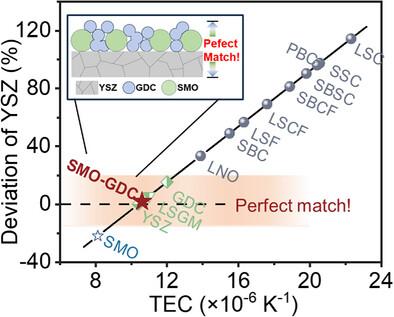Thermal Expansion Matching as a Key Criterion for Developing High‐Performance Mn‐based Mullite Cathodes in SOFCs
IF 26.8
1区 材料科学
Q1 CHEMISTRY, MULTIDISCIPLINARY
引用次数: 0
Abstract
Thermal expansion matching is crucial for solid oxide fuel cell (SOFC) cathode design to prevent interfacial delamination or cracking. This work adopts thermal expansion coefficient (TEC) matching as the primary design principle to enable both structural stability and high catalytic activity. A Mn‐based mullite‐type cathode, SmMn

热膨胀匹配是sofc中高性能锰基莫来石阴极开发的关键标准
热膨胀匹配是固体氧化物燃料电池(SOFC)阴极设计中防止界面分层或开裂的关键。这项工作采用热膨胀系数(TEC)匹配作为主要设计原则,以实现结构稳定性和高催化活性。研制了锰基莫来石型阴极SmMn2O5 (SMO),制备了GDC为Gd0.1Ce0.9O1.95 (GDC)的复合电极。为了揭示结构-性能关系,TEC和电化学性能测量与原位X射线衍射(XRD),拉曼光谱和密度泛函理论(DFT)分析相结合。由于x射线衍射(XRD)和拉曼光谱证实了SMO的各向异性晶格膨胀和声子散射,其TEC (8.12 × 10−6 K−1)较低。SMO-GDC复合材料显示出与氧化钇稳定的氧化锆极好匹配的tec,在整个工作范围内只有2.36%的偏差。电化学上,复合阴极达到580.9 mW cm - 2,极化电阻为0.193 Ω cm2,稳定运行300 h。DFT进一步表明,GDC的加入促进了界面电荷转移,缩短了Mn-Mn二聚体的时间,从而解释了催化活性的增强。这种以TEC匹配优先为主要原则的阴极材料选择策略为SOFC阴极的开发提供了新的见解。
本文章由计算机程序翻译,如有差异,请以英文原文为准。
求助全文
约1分钟内获得全文
求助全文
来源期刊

Advanced Materials
工程技术-材料科学:综合
CiteScore
43.00
自引率
4.10%
发文量
2182
审稿时长
2 months
期刊介绍:
Advanced Materials, one of the world's most prestigious journals and the foundation of the Advanced portfolio, is the home of choice for best-in-class materials science for more than 30 years. Following this fast-growing and interdisciplinary field, we are considering and publishing the most important discoveries on any and all materials from materials scientists, chemists, physicists, engineers as well as health and life scientists and bringing you the latest results and trends in modern materials-related research every week.
 求助内容:
求助内容: 应助结果提醒方式:
应助结果提醒方式:


